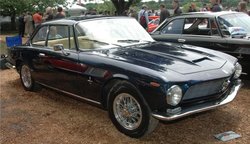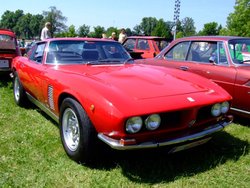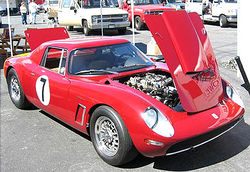Difference between revisions of "ISO"
m |
|||
| (24 intermediate revisions by the same user not shown) | |||
| Line 1: | Line 1: | ||
| − | |||
[[Image:iso_logo3.gif|center]] | [[Image:iso_logo3.gif|center]] | ||
| + | {| border=1 cellspacing=3 cellpadding=4 style="float:right; margin:0 0 .5em 1em; width:250px; background:#505050; border-collapse:collapse; border:1px solid #999; font-size:83%; line-height:1.5; " summary="Infobox Automobile" | ||
| + | |- style="text-align:center; background:#505050;" | ||
| + | |- style="color:#fff; background:darkred; font-size:larger;" | ||
| + | ! colspan=2 |'''Iso Rivolta''' | ||
| + | |- | ||
| + | |Foundation || 1953 | ||
| + | |- | ||
| + | |Defunct || 1974 | ||
| + | |- | ||
| + | |Fate || bankrupt | ||
| + | |- | ||
| + | |Location || [[Bresso]], [[Italy]] | ||
| + | |- | ||
| + | |Industry || [[Automotive]] | ||
| + | |- | ||
| + | |Key people || [[Renzo Rivolta]], founder | ||
| + | |- | ||
| + | |Products || [[Automobiles]], [[Motorbikes]] | ||
| + | |- | ||
| + | |Parent || | ||
| + | |} | ||
| + | {{X}} | ||
| + | [[Image:Iso Rivolta.JPG|thumb|right|250px|'''1967 Iso Rivolta IR 300 GT Coupe''']] | ||
| + | [[Image:Iso Grifo A3 L 1.JPG|thumb|right|250px|'''Iso Grifo A3''']] | ||
| + | [[File:1965 Iso Rivolta Daytona.jpg|thumb|right|250px|'''1965 Iso Rivolta Daytona''']] | ||
| + | |||
| + | <big>ISO</big> | ||
| + | ---- | ||
| − | '''Iso''' was | + | The motor company '''Iso Rivolta''' (Iso Motors since 1973) was initially named '''Isothermos''' and used to manufacture refrigeration units. The company was originally founded in [[Genoa]] in 1939 (but transferred to [[Bresso]] in 1942) by [[Renzo Rivolta]], an engineer. |
| − | + | After the Second World War, the company reopened its doors, completely changing its activity in 1948 it began to build [[motorcycles]], scooters and motocarries (three wheeled transport scooters/motorcycles). Among the most famous are the Furetto (1948), 'Isoscooter (1950),' Isocarro (1951), 'Isomoto (1954) and' Isosport (1953). The last Iso motorcycle was presented as the Iso 500 in 1961. | |
| − | == | + | In 1953 [[Renzo Rivolta]], heir of an important family of industrialists of [[Bresso]], a small town on the outskirts of [[Milan]] ([[Italy]]), changed his production portfolio to mopeds and motorbikes instead (Isomotos). The company '''Iso Autoveicoli S.p.a.''' was founded in 1953. |
| + | |||
| + | [[Isomotos]] were known as expensive, but durable and well-built. In the mid-1950s, he started to develop a miniature car for two persons and front entrance, initially with only three wheels, later, for reasons of stability, with four wheels (the two on the rear very close together): the [[Isetta]] Bubble Car. | ||
| + | |||
| + | Starting in 1954, Isetta was licensed to automobile manufacturers in several countries: France (by [[VELAM]]), Spain, Great Britain and Brazil (by [[Romi]]). The most successful, however, was the German Isetta built by [[BMW]]. The BMW-Isetta fulfilled the dream of mobility in post-war Germany and about 130.000 were sold until 1962. | ||
| + | |||
| + | Together with the engineer [[Giotto Bizzarrini]], the designer [[Giorgetto Giugiaro]] and the body-experts of [[Bertone]], Renzo Rivolta began developing the [[Iso Rivolta IR 300]] (presented on the [[Torino]] Show of 1962), an elegant 2 + 2 [[Coupé]] with well-balanced technical components and outstanding driving performance: the 5.4 L V8 [[Chevrolet Small-Block engine]] came from [[General Motors Corporation|General Motors]] in Detroit, the transmission, too, axles (de Dion) and braking system (4 [[disc brakes]]!) came from the large [[Jaguar (car)|Jaguar]]s of the time. This concept was maintained for almost all production cars of Iso. Starting in 1971, [[Ford Motor Company|Ford]] [[351 Cleveland]] engines replaced the GM small block. The most well-known [[Gran Turismo]] of Iso Rivolta was without doubt the Iso Grifo with berlinetta body by [[Bertone]], first presented as a very sporty, low-slung prototype (Grifo A3C) in 1964. After [[Bizzarrini]] split out of the project, this prototype formed the basis for his own [[Bizzarini 5300 GT]]. The [[Grifo]] [[Prototype]] was further refined by Iso, receiving a reworked, less aggressive and more luxurious body in the process, and went into production in 1965. The Grifo was powered by [[Chevrolet]]´s 327 V-8 (5.4 L) in either 300 or 350 hp form. In 1966 a convertible version of the Grifo was shown that didn't manage to go into production. Starting in 1968 the Grifo could also be had with Chevrolet's 427 ci big-block V-8; this version was known as the ''Grifo 7 litri'' and was easily recognized by the broad air inlet on the hood. Later-day Grifos, the Series II, featured concealed [[headlights]] and a slightly modfied front area. | ||
| + | |||
| + | After the sudden death of Renzo Rivolta, his son Piero became the director of [[Iso Rivolta]] in 1966 (aged only 25 then). Under his leadership, Iso built the [[limousine]] [[Fidia]], "the fastest four seats on wheels" (Advertisement, 1967) with body by [[Ghia]], the Grifo 7 litri (with the GM V8 7 L marine engine) and the 2 + 2 fastback Coupé Lele (1970) with body designed by [[Bertone]], intended as the successor to the IR 300. Iso Rivolta went bankrupt in 1974, only 1.700 Iso Gran Turismos had been built in those ten years. | ||
| + | |||
| + | Today, Piero Rivolta and his wife Lele live in Sarasota, Florida. His son Renzo is leading Rivolta Marine, his daughter, Marietta, is in the management of [[Zagato]] Centrostile, Milan, Italy, she is married to [[Andrea Zagato]]. | ||
| + | |||
| + | == ISO Models == | ||
| + | |||
| + | {| border=1 cellspacing=3 cellpadding=4 style="float:center; margin:0 0 .5em 1em; width:400px; background:#505050; border-collapse:collapse; border:1px solid #999; font-size:83%; line-height:1.5; " summary="Infobox Automobile" | ||
| + | |- style="text-align:center; background:#505050;" | ||
| + | |- tr BGCOLOR=darkred | ||
| + | | style="background:darkred;text-align:center" | '''Years''' | ||
| + | | style="background:darkred;text-align:center" | '''Model''' | ||
| + | | style="background:darkred;text-align:center" | '''Power''' | ||
| + | | style="background:darkred;text-align:center" | '''Top speed''' | ||
| + | | style="background:darkred;text-align:center" | '''Notes''' | ||
| + | | style="background:darkred;text-align:center" | '''Image''' | ||
| + | |- | ||
| + | | '''1962-1968''' | ||
| + | | [[Isetta]] | ||
| + | | - | ||
| + | | - | ||
| + | | | ||
| + | | [[Image:Iso Isetta.jpg|100px]] | ||
| + | |- | ||
| + | | '''1962-1968''' | ||
| + | | [[Iso Rivolta IR 300]] | ||
| + | | 300PS | ||
| + | | 215km/h | ||
| + | | | ||
| + | | [[Image:Iso_Rivolta_1969.JPG|100px]] | ||
| + | |- | ||
| + | | '''1964''' | ||
| + | | [[Iso Grifo|Grifo A3 L]] | ||
| + | | 350PS | ||
| + | | 210-275 km/h (130-171 mph) | ||
| + | | | ||
| + | | [[Image:Iso_Grifo_A3_L_1.JPG|100px]] | ||
| + | |- | ||
| + | | '''1966-1973''' | ||
| + | | [[Iso Grifo|Grifo Lusso GL 300]] | ||
| + | | 300PS | ||
| + | | 190km/h | ||
| + | | | ||
| + | | | ||
| + | |- | ||
| + | | '''1967-1974''' | ||
| + | | [[Iso Fidia|Fidia 300 / S4]] | ||
| + | | 300PS | ||
| + | | 220km/h | ||
| + | | | ||
| + | | [[Image:Iso Fidia.jpg|100px]] | ||
| + | |- | ||
| + | | '''1967-1974''' | ||
| + | | [[Iso Lele|Lele 300]] | ||
| + | | 300PS | ||
| + | | 230km/h | ||
| + | | | ||
| + | | [[Image:Iso Lele in profile in London.jpg|100px]] | ||
| + | |- | ||
| + | | '''1970-1974''' | ||
| + | | [[Iso Grifo|Grifo 7 Litri]] | ||
| + | | 406PS | ||
| + | | 300km/h | ||
| + | | | ||
| + | | [[Image:Iso_Grifo_a_FrankfurtM.JPG|100px]] | ||
| + | |- | ||
| + | | '''1970-1974''' | ||
| + | | [[Iso Grifo|Grifo Can Am]] | ||
| + | | 395PS | ||
| + | | 270km/h | ||
| + | | | ||
| + | | | ||
| + | |- | ||
| + | |} | ||
| + | |||
| + | ===Prototypes=== | ||
| + | * 1972 prototype [[Iso Varedo]] | ||
| + | * 1993 prototype [[Iso Grifo 90]] | ||
| + | * 1996 prototype [[Iso Grifo 96]] | ||
| − | |||
| − | |||
| − | |||
| − | |||
| − | |||
| − | |||
| − | |||
| − | |||
| − | |||
| − | |||
| − | |||
| − | ==External links== | + | == External links == |
| − | *[http://www. | + | * [http://classicscars.com/chassis/iso.htm ISO - BIZZARRINI chassis numbers] |
| + | * [http://www.vandergeld.org/isorivolta.htm The Iso Rivolta Automobiles] by Dutch collector Marvin van der Geld | ||
| + | *http://www.classicscars.com/chassis/iso.htm Database Chassis Number for early Iso A3C | ||
| − | + | {{ISO}} | |
| + | {{-}} | ||
| + | {{A-Z multipage list|Car Information and Photos by Marque|Information and Photos by Marque|}} | ||
| + | {{A-Z multipage list|Motorcycle Information and Photos by Marque|Motorcycle Information and Photos by Marque|}} | ||
| + | {{Car Information and Photos by Marque}} | ||
| + | {{Motorcycle Information and Photos by Marque}} | ||
Latest revision as of 09:08, 3 May 2010
| Iso Rivolta | |
|---|---|
| Foundation | 1953 |
| Defunct | 1974 |
| Fate | bankrupt |
| Location | Bresso, Italy |
| Industry | Automotive |
| Key people | Renzo Rivolta, founder |
| Products | Automobiles, Motorbikes |
| Parent | |
ISO
The motor company Iso Rivolta (Iso Motors since 1973) was initially named Isothermos and used to manufacture refrigeration units. The company was originally founded in Genoa in 1939 (but transferred to Bresso in 1942) by Renzo Rivolta, an engineer.
After the Second World War, the company reopened its doors, completely changing its activity in 1948 it began to build motorcycles, scooters and motocarries (three wheeled transport scooters/motorcycles). Among the most famous are the Furetto (1948), 'Isoscooter (1950),' Isocarro (1951), 'Isomoto (1954) and' Isosport (1953). The last Iso motorcycle was presented as the Iso 500 in 1961.
In 1953 Renzo Rivolta, heir of an important family of industrialists of Bresso, a small town on the outskirts of Milan (Italy), changed his production portfolio to mopeds and motorbikes instead (Isomotos). The company Iso Autoveicoli S.p.a. was founded in 1953.
Isomotos were known as expensive, but durable and well-built. In the mid-1950s, he started to develop a miniature car for two persons and front entrance, initially with only three wheels, later, for reasons of stability, with four wheels (the two on the rear very close together): the Isetta Bubble Car.
Starting in 1954, Isetta was licensed to automobile manufacturers in several countries: France (by VELAM), Spain, Great Britain and Brazil (by Romi). The most successful, however, was the German Isetta built by BMW. The BMW-Isetta fulfilled the dream of mobility in post-war Germany and about 130.000 were sold until 1962.
Together with the engineer Giotto Bizzarrini, the designer Giorgetto Giugiaro and the body-experts of Bertone, Renzo Rivolta began developing the Iso Rivolta IR 300 (presented on the Torino Show of 1962), an elegant 2 + 2 Coupé with well-balanced technical components and outstanding driving performance: the 5.4 L V8 Chevrolet Small-Block engine came from General Motors in Detroit, the transmission, too, axles (de Dion) and braking system (4 disc brakes!) came from the large Jaguars of the time. This concept was maintained for almost all production cars of Iso. Starting in 1971, Ford 351 Cleveland engines replaced the GM small block. The most well-known Gran Turismo of Iso Rivolta was without doubt the Iso Grifo with berlinetta body by Bertone, first presented as a very sporty, low-slung prototype (Grifo A3C) in 1964. After Bizzarrini split out of the project, this prototype formed the basis for his own Bizzarini 5300 GT. The Grifo Prototype was further refined by Iso, receiving a reworked, less aggressive and more luxurious body in the process, and went into production in 1965. The Grifo was powered by Chevrolet´s 327 V-8 (5.4 L) in either 300 or 350 hp form. In 1966 a convertible version of the Grifo was shown that didn't manage to go into production. Starting in 1968 the Grifo could also be had with Chevrolet's 427 ci big-block V-8; this version was known as the Grifo 7 litri and was easily recognized by the broad air inlet on the hood. Later-day Grifos, the Series II, featured concealed headlights and a slightly modfied front area.
After the sudden death of Renzo Rivolta, his son Piero became the director of Iso Rivolta in 1966 (aged only 25 then). Under his leadership, Iso built the limousine Fidia, "the fastest four seats on wheels" (Advertisement, 1967) with body by Ghia, the Grifo 7 litri (with the GM V8 7 L marine engine) and the 2 + 2 fastback Coupé Lele (1970) with body designed by Bertone, intended as the successor to the IR 300. Iso Rivolta went bankrupt in 1974, only 1.700 Iso Gran Turismos had been built in those ten years.
Today, Piero Rivolta and his wife Lele live in Sarasota, Florida. His son Renzo is leading Rivolta Marine, his daughter, Marietta, is in the management of Zagato Centrostile, Milan, Italy, she is married to Andrea Zagato.
ISO Models
| Years | Model | Power | Top speed | Notes | Image |
| 1962-1968 | Isetta | - | - | 
| |
| 1962-1968 | Iso Rivolta IR 300 | 300PS | 215km/h | 
| |
| 1964 | Grifo A3 L | 350PS | 210-275 km/h (130-171 mph) | 
| |
| 1966-1973 | Grifo Lusso GL 300 | 300PS | 190km/h | ||
| 1967-1974 | Fidia 300 / S4 | 300PS | 220km/h | 100px | |
| 1967-1974 | Lele 300 | 300PS | 230km/h | ||
| 1970-1974 | Grifo 7 Litri | 406PS | 300km/h | 
| |
| 1970-1974 | Grifo Can Am | 395PS | 270km/h |
Prototypes
- 1972 prototype Iso Varedo
- 1993 prototype Iso Grifo 90
- 1996 prototype Iso Grifo 96
External links
- ISO - BIZZARRINI chassis numbers
- The Iso Rivolta Automobiles by Dutch collector Marvin van der Geld
- http://www.classicscars.com/chassis/iso.htm Database Chassis Number for early Iso A3C
| ISO S.p.A. | |
|---|---|
| Rivolta | Grifo | Fidia | Lele | Varedo | Grifo 90 | Grifo 96 |
| Car Information and Photos by Marque: A - B - C - D - E - F - G - H - I - J - K - L - M - N - O - P - Q - R - S - T - U - V - W - X - Y - Z |
| Motorcycle Information and Photos by Marque: A - B - C - D - E - F - G - H - I - J - K - L - M - N - O - P - Q - R - S - T - U - V - W - X - Y - Z |


